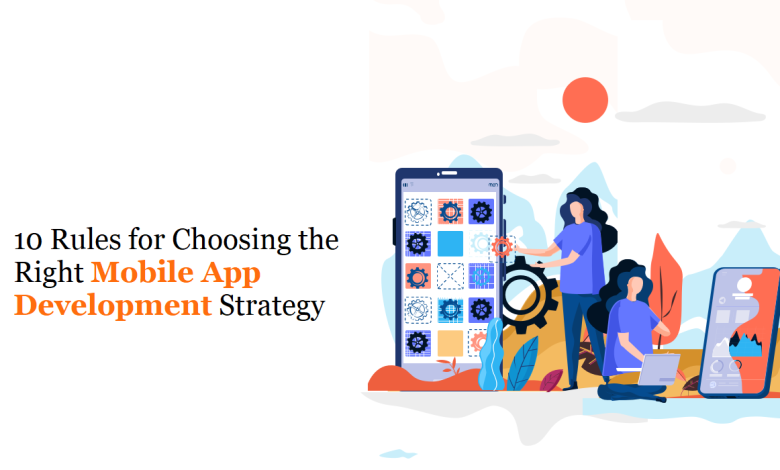10 Rules for Choosing the Right Mobile App Development Strategy

Mobile systems or smartphones are undeniably widespread in this post-modern era. Small but powerful devices are ubiquitous in almost every area of our daily routine-whether it’s grocery shopping, finding a food outlet, or getting the perfect birthday gift. Present-day ‘apps’, which were unknown till a few years back, are more of a necessity than a choice.
This is because we want visual coordination between people’s behaviour and their mobile capabilities. Naturally, the increasing use of smartphones and portable devices has completely changed how we communicate with our enterprise software systems.
With the incredible increase in the use of mobile devices, there is an exponential demand for the use of customizable enterprise mobile application development strategy across various organizational structures. If this happens, you can ensure easy remote access to relevant corporate applications and data whenever the business needs it.
Setting up a mobile enterprise app without any strategic framework or thinking wrong will only hamper your business operations and reduce ROI. To adapt to the growing and ever-changing demands of modern business workflows, you first need to develop a sustainable mobile app development process.
By this, we mean an approach that can increase the productivity of your employees and help you outperform your competitors in the long run.
Before getting into the technical side of the question, let’s identify your mobile app development strategy, objectives, and monetization model.
1. Define a Clear, Unique Value Proposition
UVP should be concise, clear and easy to understand. Before building a mobile app, you need to think about what will be useful to the audience or audience that will use your application. As you develop your project charter, you should ask yourself some basic questions:
- Who is my target audience?
- What are they trying to achieve in the mobile setting?
- How do I use the mobile app? What resources can my program bring, and where do I need assistance from
- the communications staff regarding promotion and marketing?
- How do I measure success?
- What is a mobile app’s expected end of life (EOL)?
- What unique value will your application bring to your customers?
2. Set Goals and Performance Standards
Set goals for your application that are relevant to your business decisions. For example, you might want to open new sources of income or improve customer satisfaction. On top of that, set clear performance benchmarks and KPIs that will help you measure the success of your application – load speed, crash reports, retention rates and more.
3. Analyse User Profile
Who is your target user, and what problems are you trying to solve? What value do they have in the application, and what are their needs and pain points?
4. Define the features to be used in the app
It’s never a good idea to use too much information and try to solve multiple problems in one solution. Users will be overwhelmed and confused by the complexity, navigation, and features and leave your device.
5. Make sure the data is secure
Your mobile application will manage and store a lot of data, including sensitive customer information. Your reputation is at stake when it comes to security, as exposing customer data can have very serious consequences. Decide how you will protect your company and users’ data.
6. Data collection and its utilization
Now the data is safe and secure, but what are you doing with it? How do you make the most of your information to grow your business?
You can use the data collected from your marketing campaign to gain market information, establish behaviour patterns, engage with audiences and promote new products.
7. Select Monetization Model
Monetization is a way to convert money into revenue streams. If the income generated does not exceed the expenditure, your application will not be successful and lead to bankruptcy. On the other hand, your business will benefit greatly if new customers bring in more value than you used to get them.
8. Selecting the right development technology
To determine the best development technology for your mobile app, you need to evaluate the issue based on key factors such as local experience, cost of development, market timing, ease of deployment and application management.
The mobile app development company focuses on the following types of mobile application development and outlines the pros and cons of each of them:
- Mobile Web App Development (Select)
- Hybrid App Development (Select)
- Native Mobile App Development
9. Choosing the best deployment platform
The mobile app developer uses HTML5, CSS3 and JavaScript for developing mobile and web apps. The application runs on a web server, can be accessed through a web browser and are portable across multiple mobile platforms.
These mobile web apps will leverage standalone templates or built into Drupal, both fully responsive for different screen sizes.
However, it is impossible to create an original and rich UX using this strategy. Even though HTML5 can take advantage of certain device-specific functions and offline stores, constraints exist due to the sandbox nature of some platforms and the extent to which native browser components adopt HTML5 specifications on a user’s device.
The following evaluation criteria should be considered while selecting which mobile application development strategy will be adopted by the company.
- Basic UX
- portability
- market timing
- Maintenance and Management
- ease of deployment
10. Approval and marketing
This is the final step. However, your work does not end here. Before the official launch of your mobile app, you need to get approval from the operating systems. After the official release, you have to collect feedback and implement new features or remove some functionality according to user feedback.
When you’re promoting your mobile app, your goal isn’t just to get traffic – it’s to lead those visitors and eventually convert them into buyers. Promoting your mobile app is an important part of building a business. If you don’t promote your app, no one will know it exists.
The best option to encourage your mobile app is to focus on the benefits of your users by downloading the app. Don’t just focus on the features you offer or the app’s design.
There are several concepts you can facilitate your mobile app, including:
- Social media
- Blogging
- Speaking at events
- Advertisements in trade magazines
- Advertising on radio
- Advertisements in newspapers
- Advertisement on hoardings
- Advertisements on buses
- Display ads on your website
Final thoughts
The right strategy for your application can be as complex as you want it to be, but it should always be rooted in your specific goals and what will help you accomplish those goals. You can avoid common pitfalls and create a functional and successful application by doing this.
The strategic components of mobile app development for iOS and Android are about setting your goals, evaluating your company’s strengths, evaluating the market for your product, and hire dedicated mobile app developers. If you pay attention to these issues, you can avoid costly mistakes and offer a profitable application.





